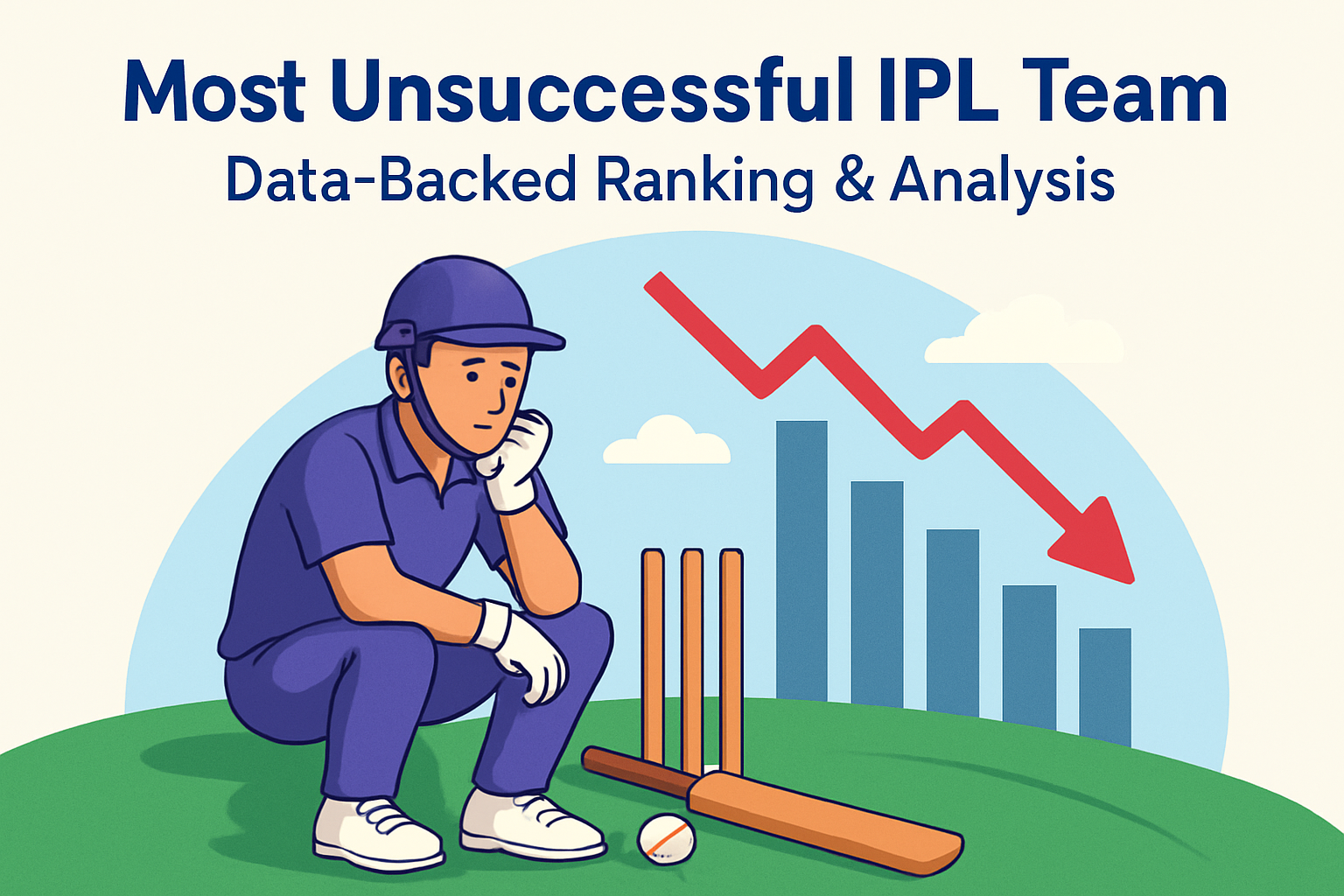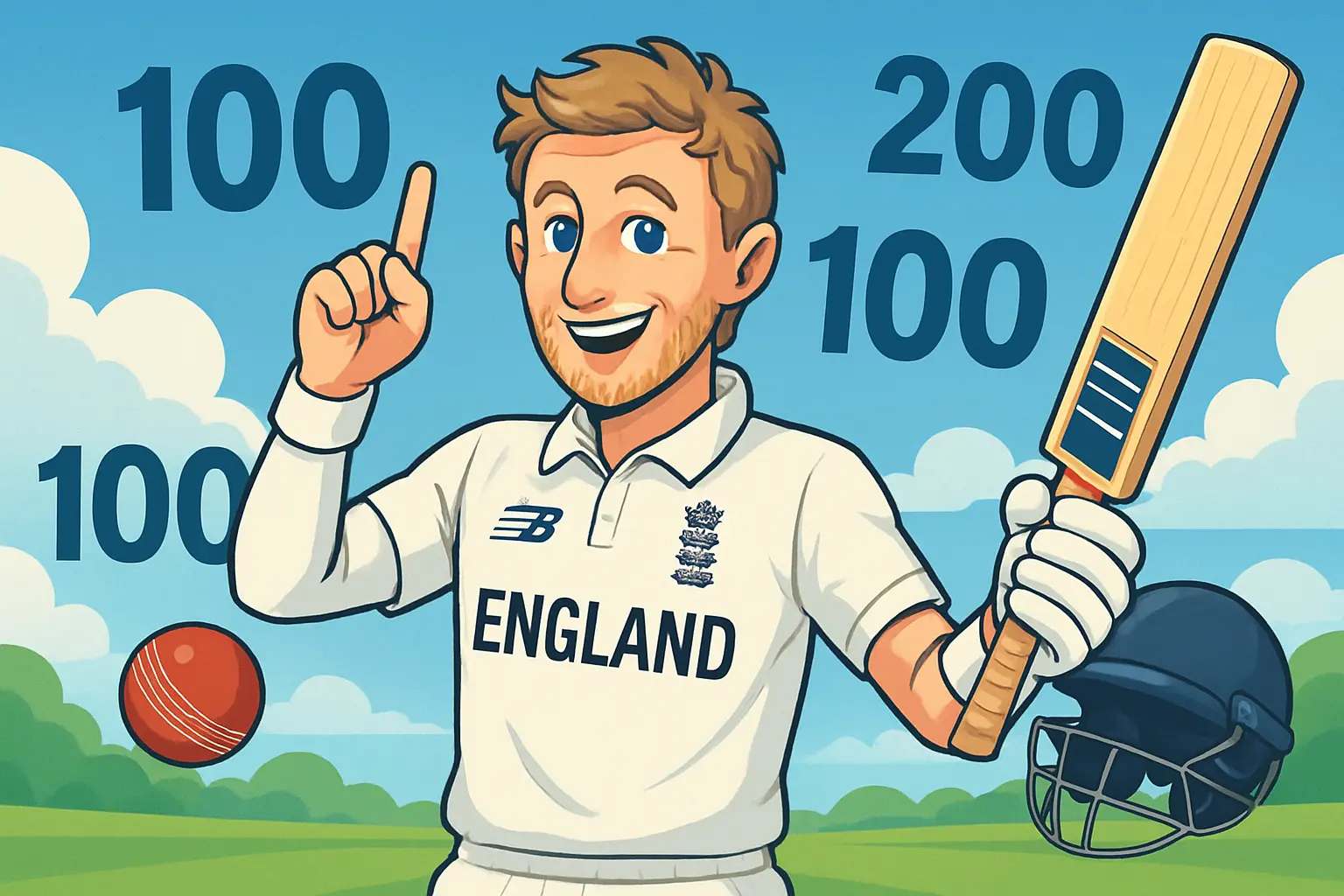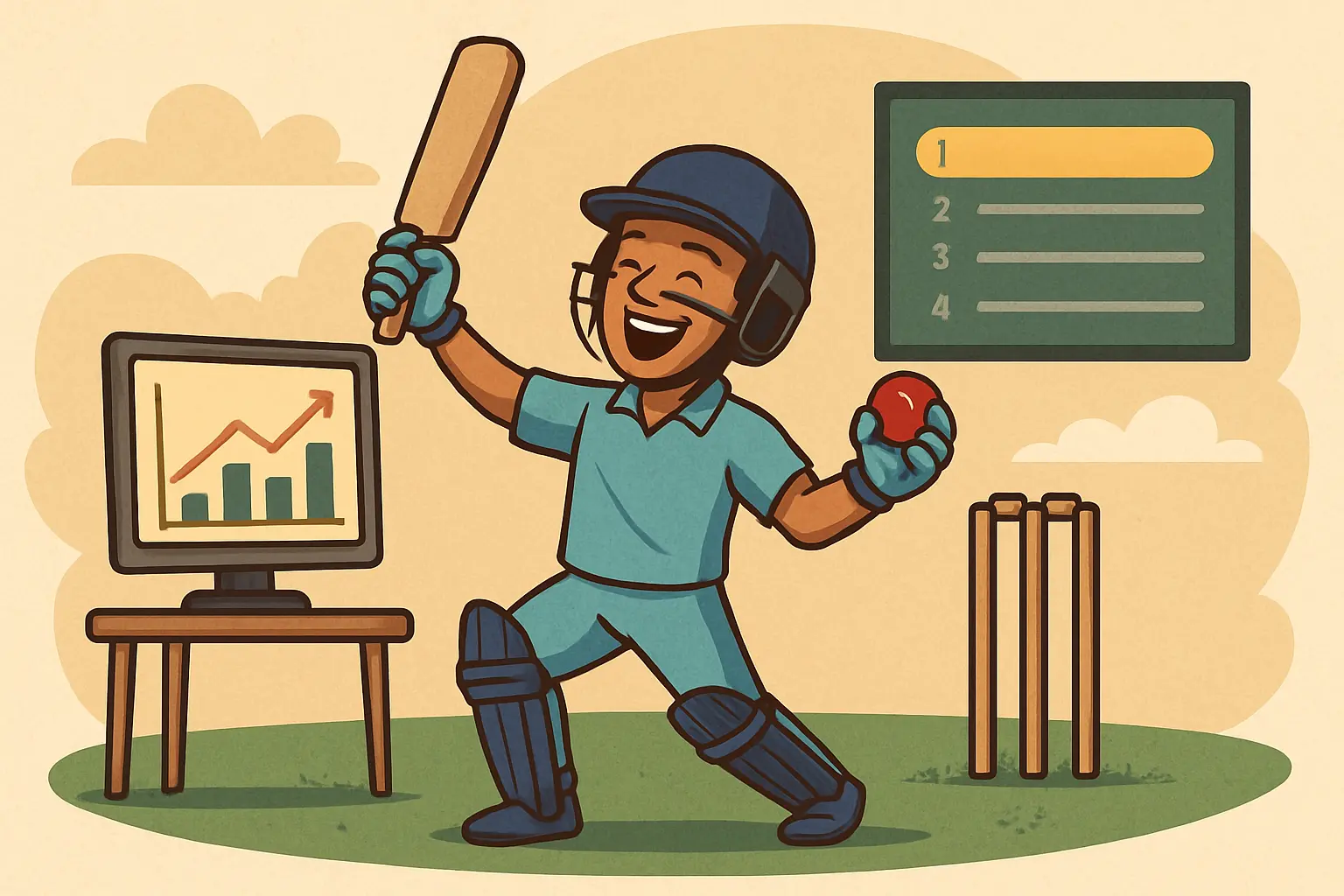
The league’s noise is a seduction: pop songs thumping across floodlit nights, cameras panning to a celebrity owner, a captain striding out to the toss while a million scrolling thumbs pause. But beneath the glitz lives a cold ledger. Titles. Win percentage. Playoffs. Wooden spoons. Losing streaks that shape auctions, ruin seasons, and test a fan base’s faith.
This is a ranking of the most unsuccessful IPL teams, anchored in numbers and built with context only the league itself can teach you. It is not a simple count of trophies. It’s an honest, sometimes uncomfortable look at underperforming IPL teams over the league’s full arc—who failed, why they failed, and how we should measure failure at all.
Methodology: How “unsuccessful” is defined and scored
A team can be loved and still be the least successful team in IPL. A team can be thrilling and still carry the tag of worst IPL team from a purely statistical vantage. To avoid shallow listicles and anecdotes, I use a weighted scoring model that blends outcome and process. The intent is clear: titles matter most, but consistency and competitiveness belong in the conversation.
Scoring weights
- Titles: 40%
- Playoff appearances: 15%
- Win percentage (all-time): 20%
- Finals lost (without a title): 5% penalty
- Wooden spoon finishes (last place): 10% penalty
- Longest losing streak: 5% penalty
- Average season points: 5%
- All-time average NRR: 5%
Rationale
- Titles define eras. They carry the heaviest weight.
- Playoffs are the market of consistency—a team playing knockout cricket regularly is doing something right across auctions and seasons.
- Win percentage is the cleanest long-term indicator of overall strength.
- Wooden spoons and long losing streaks are reliable warning sirens. They reveal structural issues—scouting, role clarity, captaincy instability—that don’t hide in small samples.
- Finals lost is penalized, but lightly. Reaching a final is a significant marker of quality; however, repeated failure at the last step matters for a “worst performing IPL team” diagnosis.
All claims below are based on officially recorded results up to the latest completed season.
The all-time picture: the zero‑title club and the weight of drought
There is a special pressure attached to teams with zero titles. Every mini form slump is magnified. Every auction is a referendum. The freshest wounds don’t belong to teams that never compete; they belong to teams that almost get there and go home empty.
Active franchises with zero titles
- Royal Challengers Bangalore
- Delhi Capitals
- Punjab Kings
- Lucknow Super Giants
Defunct or short-lived franchises without titles
- Pune Warriors India
- Kochi Tuskers Kerala
- Gujarat Lions
- Rising Pune Supergiant
Only one of those defunct franchises is truly synonymous with failure in the numbers: Pune Warriors India, who finished near the bottom repeatedly, clocked one of the lowest win percentages in IPL history, and stitched together a double-digit losing streak. Kochi lasted a single season and were mid-table by feel; Gujarat Lions were competitive; Rising Pune Supergiant reached a final. They are footnotes. Pune Warriors are a case study.
Top 5 most unsuccessful IPL teams: a data‑backed ranking
1) Pune Warriors India
Verdict: The worst team in IPL history by long-form metrics.
Why they top the list:
- Lowest win percentage in IPL history across a multi-season sample.
- Multiple last-place finishes.
- An extended losing streak that became emblematic of a team struggling on and off the park.
- Their recruitment was often reactive. Roles blurred. The side drifted between rebuild and relevance, never landing either.
- Coaching changes and ownership turbulence bled directly into selection.
Tactical profile: Bowled too many floaters at the death, missed the yorker count, and rarely found an in-form Indian finisher to close tight chases. When they defended, they lost the powerplay too often. When they chased, they paid a tax in dot balls in the middle overs and didn’t have the finishing muscle to claw it back.
Legacy note: The case everyone cites when arguing that stability and scouting are not optional in this league.
2) Punjab Kings
Verdict: The most unsuccessful IPL team among active franchises by the weight of drought and inconsistency.
Why they rank here:
- No title, a sparse playoff record, and a long streak of seasons floating in mid-table or lower.
- PBKS have too many seasons where they enter the final fortnight still searching for their best batting order.
- They’ve had marquee performers—some seasons the Orange Cap chase came wrapped in their jersey—but single-player fireworks rarely translated into resilient campaigns.
Tactical profile:
- Over-reliance on top-order overseas batting has often left the Indian middle light.
- Bowling churn, especially at the death, cost them a stack of points; death overs economy routinely ran heavy.
- Wrist-spin resources were thin in multiple seasons, which hurt on dry pitches.
Structural issues: Captaincy and coaching turnover impaired culture continuity. Auction identity shifted too often—one cycle all-in on six-hitting, the next on pace; scarce investment in Indian lower-middle-order finishers.
Home‑ground effect: Multiple “home” venues across seasons never let them build a cauldron. The atmosphere is loyal and loud, but the cricketing fingerprint—what kind of deck they want, how their attack stacks up to it—never fully settled.
3) Delhi Capitals
Verdict: An underperforming IPL team historically, vastly improved in patches but still a member of the zero-title burden.
Why they rank here:
- Across the league’s full timeline, Delhi own the most losses among active franchises.
- They’ve carried multiple wooden spoons and long lean stretches where they seemed unsure if they were rebuilding or contending.
- The rebrand and a new cricket operations model sparked a brighter period that included a final and regular playoff pushes, yet the ledger still tilts red overall.
Tactical profile:
- When they’re good, they’re good because of bowling: a left-arm angle, a heavy-hard-length plan, and a pair of spinners controlling the middle.
- When they’re bad, it’s because the powerplay batting leaks dot balls and the finishing role vacillates between two players not entirely comfortable in it.
Structural issues: Injuries to key Indian pillars derailed seasons. The bench lacked like-for-like replacements for wicketkeeping batters and death bowlers. Overseas recruitment skewed to top-order batters in some cycles, starving other roles.
Note on improvement: Delhi’s scouting pipeline has produced cheap Indian pace, versatile spin, and dynamic fielding. That is the roadmap. But the absence of a title and a heavy loss column keep them near the top of the most unsuccessful list.
4) Royal Challengers Bangalore
Verdict: An enigma—high visibility, high talent density, no trophy. By pure consistency they are not the worst IPL team; by the weight of expectation and finals lost without a title, they grade as an unsuccessful IPL team in the only metric that matters to fans.
Why they rank here:
- Zero titles across a full membership of seasons.
- Three finals lost.
- Multiple playoff appearances that ended in eliminators or qualifier defeats.
- RCB’s long-term win percentage sits in the middle band, not bottom, but the drought and heartbreak index is unrivaled among active clubs.
Tactical profile:
- Batting brilliance has never been the problem; finding repeatable wickets at the death and protecting shorter boundaries has been.
- Their home venue is a six-hitter’s dream, which turns every par score into a moving target. It also exposes middling death bowling more than any ground in the league.
- Over the years, the balance has often tilted toward a top-heavy batting order with limited bowling elasticity when the pitch flattened.
Structural issues: A carousel of directors, coaches, and captaincy identities created discontinuity between auction plans and on-field execution. Some seasons the squad looked built for away games; some seasons for home. Rarely both.
The counterpoint: When the bowling clicked—think periods where the powerplay length discipline came with a harder ball and the death overs found the yorker—the team looked like a champion. Those patches just didn’t come often enough in the same season as healthy top-order form and fielding excellence.
5) Kochi Tuskers Kerala
Verdict: Not a bad cricket team on the field, but they occupy this slot because success needs seasons, and Kochi had only one. No playoffs, no title, just an unfinished sentence.
Why they rank here: A single campaign is too small a sample to call them the worst team in IPL history, and in fact their cricket was competitive. But this is a list of the least successful teams, and success requires continuity. With no deep run and no second act, Kochi’s record reads like a prologue.
A note on short-lived but competitive sides
Gujarat Lions: topped a league table once, no title; not a candidate for “worst.”
Rising Pune Supergiant: reached a final and were a serious contender; not a candidate for “worst.”
These sides played tidy, modern T20 cricket and lost key games by thin margins. That is not failure in the deepest sense; it is just unfinished business.
The zero‑title club (active): where each team truly stands
A quick, practical snapshot that fans ask for every week. This is the “which IPL team is most unsuccessful” conversation distilled to the current teams without a trophy.
Active teams with zero titles at a glance
Royal Challengers Bangalore
- Seasons played: full membership since inception
- Finals: multiple, all lost
- Playoff seasons: frequent enough to avoid the “worst” tag by consistency
- Win% band: mid
- Wooden spoons: rare
- Notable strength: marquee batting, crowd energy, the league’s loudest nights
- Recurring flaw: death bowling repeatability on flat decks
Delhi Capitals
- Seasons played: full membership since inception
- Finals: one
- Playoff seasons: clustered in purple patches, long absences otherwise
- Win% band: low-mid
- Wooden spoons: multiple
- Notable strength: when balanced, their bowling unit can choke games in the middle overs
- Recurring flaw: powerplay batting stalls; finishing flux
Punjab Kings
- Seasons played: full membership since inception
- Finals: one
- Playoff seasons: few
- Win% band: low
- Wooden spoons: multiple
- Notable strength: individual brilliance and fearless striking
- Recurring flaw: death overs economy, unstable roles
Lucknow Super Giants
- Seasons played: short
- Finals: none
- Playoff seasons: immediate in early years, then mixed
- Win% band: mid-high for zero-title teams
- Wooden spoons: none
- Notable strength: role clarity in the top six, power hitters balanced with pace
- Recurring flaw: knock-out anxiety, middling death bowling when injuries hit
Defunct franchises: context for the bottom of the table
Pune Warriors India
The archetype of a struggling IPL team. Lowest win percentage among teams with a meaningful sample, multiple wooden spoons, and a losing streak that hardened into identity. Auctions often produced crowded top orders with a missing Indian finisher, or a pace attack with pace but little deception at the death.
Kochi Tuskers Kerala
Competitive within a small window. The project ended before it could stabilize. The numbers put them behind any side with deep runs, but their on-field cricket was not chaotic.
Gujarat Lions
Took advantage of a temporary window with aggressive top-order batting and smart new-ball bowling. Good league-stage players, but they never found a knockout blueprint.
Rising Pune Supergiant
A mature operation for a side with a short life cycle. Reached a final. Built on senior pros, a smart captaincy hand, and bowlers who loved holding the length on surfaces that rewarded patience.
Leaderboards that define “unsuccessful”
These are the metrics that keep reappearing whenever fans debate the worst team in IPL history. They are not gossip. They explain patterns we see every season.
IPL team with most losses ever
Delhi Capitals hold the heaviest loss count in aggregate. Seasons of churn and rebuild cycles stacked defeats, even with a recent-era reset that lifted their ceiling.
Lowest win percentage in IPL ever
Pune Warriors India own this space. Among active sides, the lowest band belongs to Punjab Kings and Delhi Capitals, with RCB sitting mid-table on pure win rate.
Most seasons without playoffs
Punjab Kings and Delhi Capitals sit at or near the top. The raw count is grim, but the bigger issue is rhythm: a playoff drought makes a franchise impatient, which leads to auction overcorrections.
Most wooden spoon finishes
Delhi and Punjab have collected multiple last-place finishes across eras, with PWI crammed near the bottom whenever they were in the league.
Longest losing streak in IPL by a team
Double-digit runs belong to Pune Warriors India and Delhi across separate eras. Long streaks almost always point to an identity crisis—no stable XI, muddled roles, and a dressing room overcompensating for each mistake.
Teams with most finals lost without winning a title
Royal Challengers Bangalore sit alone here. Three finals, all slipped away. That weighs heavy in any “most unsuccessful IPL team” debate, even when their win percentage is acceptable.
RCB vs PBKS vs DC: who is the most unsuccessful, really?
Strip the emotion and you get this.
- On pure win-loss: DC and PBKS are worse.
- On heartbreak: RCB are unmatched—finals lost, knockout exits, and a title drought under a spotlight the size of a cricketing sun.
- On instability: PBKS take the unwanted medal. A rotating captaincy and coaching corridor asked too much of any single season’s squad cohesion.
- On rebuild cycles: DC suffered more troughs, then enjoyed an undeniable uplift under a leaner structure and a clear identity.
So which IPL team is most unsuccessful among active sides? If you value titles above everything else and weigh droughts heavily, RCB’s empty cabinet across so many seasons makes a strong case. If you value consistency and loss avoidance, PBKS and DC grade lower. The fairest answer, by the methodology above, is this:
- Active “most unsuccessful” by outcome and consistency: Punjab Kings
- Active “most unsuccessful” by heartbreak index: Royal Challengers Bangalore
- Active “most unsuccessful” by total losses and wooden spoons: Delhi Capitals
Why some teams struggle: the cricket beneath the numbers
When you cover this league from dressing room to dugout, patterns jump off the whiteboard long before they appear in a scorecard. Unsuccessful IPL teams share five tactical symptoms.
1) Powerplay indecision
The most under-discussed weakness in unsuccessful teams is the powerplay trade-off. Chasing par requires both a brisk start and wickets in hand. Sides like PBKS and DC, in their down cycles, get stuck in the middle: neither hard-charging nor calmly setting up. That indecision shows up as low boundary percentage in the first six overs and a celery-soft middle where the required rate jumps beyond ten with too much still to do.
2) Death overs economy
The lifeblood of contenders is a repeatable plan from overs 16 to 20. Think back-of-length into the pitch with a deep square-leg trap on slower decks, rock-steady yorker execution when the ball stays true, and the courage to go full across the right-hander. The struggling sides often feature a carousel of death bowlers, none allowed to fail safely long enough to grow into the role. Result: the worst death overs economy in the league across multiple seasons, an anchor on the table.
3) Role clarity for finishers
The league has fewer reliable Indian finishers than teams that need them. The unsuccessful sides either over-index on overseas finishers—bottlenecking overseas slots and batting order flexibility—or trust all-rounders who are great at seven in ODI tempo but don’t possess the gear change T20 finishing demands. The fallout is predictable: a chase stalls at the end, or a par total turns sub-par by twenty.
4) Spin in the middle overs
On pitches that slow down, you win by making batters hit with or against the grip at an uncomfortable length. Unsuccessful teams sometimes carry good spinners but use them poorly—bowling them in the powerplay when match-ups aren’t right, or saving them for the death where they are exposed. The best sides treat the middle overs like a choke point, not a holding pattern.
5) Auction identity drift
This might be the biggest off-field tell. The unsuccessful teams bounce between philosophies. One auction they empty the purse on two headline overseas batters. The next they chase three quicks while ignoring domestic finishing depth. The mega auction resets are an opportunity; for underperforming IPL teams they’ve also been a trap when the shopping list reads “everything.”
Mini timelines: how dips correlate with decisions
Royal Challengers Bangalore
The superstar years often disguised structural gaps. At their best, RCB leaned into raw batting power, turning venues into launchpads. But the tightest games were decided by death bowling. When they found even one dependable end-over option—say, a right-armer landing yorkers at will, or a tall quick nailing hard lengths into the hips—the entire side rose. When they didn’t, they chased averages in the auction and ended up with a row of three-seamers doing similar jobs. Captaincy changes from homegrown talisman to overseas veteran brought calm, and coaching moves brought clarity, but that last over remained a season-long thesis defense.
Punjab Kings
The season-by-season story is painted in bold strokes: new captain, new coach, new plan. A dominant top order one season. A pace-heavy attack the next. The throughline is a lack of resource stacking: two finishers, two wrist-spin options, two death specialists. They often had one, and then prayed it held. The best mini-run came when they embraced high-tempo batting and backed it without fear; the worst when they tried to be a tempo team without middle-overs glue.
Delhi Capitals
Two distinct phases. The first stretched long and foggy, marked by too many losses and not enough identity. The second felt like a different franchise: clear bowling plans, a young Indian core, and a coaching group that drilled match-ups rather than slogans. The slip-ups since then trace back to injuries in critical roles and a recurrence of finishing uncertainties.
Lucknow Super Giants
A sprinter out of the blocks. Their tactical shape made sense from day one: anchors and hitters up top, all-rounders to float, a leggie to cut middle overs in half. What they haven’t solved is the pressure of knockouts and a brittle Plan B when a key all-rounder sits out. You can’t call them the worst performing IPL team by any reasonable metric, but the absence of a deep run keeps them in the zero-title conversation.
Pune Warriors India
The squad rarely fit together. Captaincy changed before it settled. They went to the auction with a shopping list that read like a fan forum. Some fine individual cricketers wore that kit; the cricket never matched the names. The darkest statistical markers—win percentage, losing streaks, wooden spoons—cluster around them.
What the numbers miss and the eyes catch
- Venue geometry matters. Chinnaswamy turns mishits into rows K and L. Mohali plays fair until the evening breeze lifts. Delhi can grip and turn, then suddenly skid with dew. Unsuccessful teams often fail to build an attack that “travels” while also “owning home.”
- Fielding is a tax or a dividend. Saves at extra cover and boundary take-ons at long-on are the hidden four or eight runs that separate par from panic. The bottom-table sides routinely rank low in boundary-saving metrics in their down years.
- Captaincy under lights is part memory, part nerve. The unsuccessful sides post time-outs where the eyes tell you the decision is already late: the spinner that should have bowled the fourteenth is warming up in the sixteenth, the slower-ball specialist arrives when the set batter is already on eighty.
Metric-based snapshots for fast answers
- Most unsuccessful IPL team by win percentage: Pune Warriors India
- Most losses in IPL (aggregate): Delhi Capitals
- Lowest win percentage among active teams: Punjab Kings and Delhi Capitals sit in the bottom band
- Teams without an IPL trophy right now: Royal Challengers Bangalore, Delhi Capitals, Punjab Kings, Lucknow Super Giants
- Teams that reached finals but never won: Royal Challengers Bangalore
- Most seasons without playoffs among active teams: Punjab Kings and Delhi Capitals cluster near the top
- Longest losing streak: double-digit runs held by Pune Warriors India and Delhi across separate periods
Why RCB are always in the debate
Even when not the least successful team in raw win percentage, RCB carry this conversation because:
- They have more finals lost without a title than anyone else.
- Their brand magnifies scrutiny. A prime-time fixture with a packed, roaring home base means every stumble becomes a meme and every surge a prophecy.
- Their best years are spectacular, making the off-years feel worse by contrast.
Why PBKS keep reappearing near the top
- The playoff drought stretches in too many directions. And while the franchise has had seasons of breathtaking fearlessness, the low seasons stayed low for too long. The league doesn’t forgive indecision. Neither do tables that record losses.
Why Delhi’s label is “underperforming” rather than “hopeless”
- They’ve turned over a new leaf more than once. The numbers remain heavy with losses, but the on-field model improved drastically in later periods. This is a franchise that learned how to draft quicks, trust a leggie to own the eighth through the fourteenth, and build batting around Indian pillars.
A tactical autopsy of losing seasons
- Powerplay batting: Teams in the bottom tier often post a boundary percentage in the powerplay that lags the top four by several points. That gap increases the required rate and puts finishers in a losing race.
- Powerplay bowling: Wickets inside the first six are the currency of T20 control. Unsuccessful teams go long stretches with a new ball that threatens edges but rarely takes them.
- Middle-overs squeeze: Without a wrist-spinner hitting the perfect risk-reward point or a finger-spinner with elite deception, the middle overs become a breather for set batters, not a trap.
- Death overs: The single most repeated failure. Yorkers missed by inches become sixes. Slower balls without disguise become slogs into the stands. One poor twentieth over can ruin three good ones, and bottom-table sides live this truth too often.
- Finishing: A pack of teams hopes their overseas five or six will do it; the champions develop or acquire an Indian seven who can finish and a nine who can swing a game by eight runs at the end.
Decade‑shaped arcs without the calendar
Early era: Teams were still figuring out role specialization. Underperformers loaded up on names rather than roles.
Middle era: Data improved. Teams that didn’t update selection processes stayed behind. Delhi and Punjab suffered here until structural resets kicked in.
Recent era: Margins narrowed. Auction discipline, bench depth, and injury mitigation separated contenders from everyone else. Lucknow, even without a title, showed how fast you can build competency with role-first recruitment.
Most unsuccessful IPL captains and coaches: a humane take
Naming and shaming captains or coaches by “losses” alone is lazy. The worst performing IPL teams often cycled leaders too fast for any project to mature. Captains carry the optics; management owns the ecosystem. Where the churn was constant, the failure was collective. The brave truth: some of the league’s smartest cricket minds have served during a franchise’s worst seasons. Their learnings fueled better hires and better drafts later.
The culture piece: fans, pressure, and the thing you can’t model
Spend an evening in a Bangalore stand when the chase hits twelve an over. Hear Mohali exhale when the twentieth over begins with a wide. Watch Delhi’s younger core huddle after a dropped catch and choose curiosity over blame. That is the league’s living texture. An unsuccessful IPL team isn’t a spreadsheet. It’s a thousand tiny choices under pressure. The table reflects those choices over time, but within each loss are micro-battles only players and coaches fully feel.
Rankings by category
Most unsuccessful IPL teams by overall score (blending titles, playoffs, win%, spoons, streaks)
- Pune Warriors India
- Punjab Kings
- Delhi Capitals
- Royal Challengers Bangalore
- Kochi Tuskers Kerala
Most unsuccessful IPL teams by win% alone
- Pune Warriors India (lowest all-time sample)
- Among active: Punjab Kings and Delhi Capitals in the lower band
Teams without titles, ranked by consistency
- Royal Challengers Bangalore (highest consistency without a title)
- Lucknow Super Giants (small sample, generally consistent)
- Delhi Capitals (mixed, improved in blocks)
- Punjab Kings (most inconsistent)
Teams with most finals lost without ever winning
- Royal Challengers Bangalore
Teams with the most wooden spoon seasons (broadly)
- Delhi Capitals and Punjab Kings
Teams with the most aggregate losses
- Delhi Capitals lead the ledger
Teams with the longest losing streaks
- Pune Warriors India and Delhi with double-digit runs
Defining “least successful IPL team” vs “worst IPL team”
- “Least successful” is the honest scoreboard: titles and win rate. That definition crowns Pune Warriors India all-time, and among active sides points to Punjab Kings and Delhi Capitals as bottom-tier.
- “Worst” can be a mood, a gut punch—a team that feels snake-bitten at the final hurdle. By that measure, RCB will always be in the conversation until the drought ends.
Fast facts for quick reference
- Teams without an IPL trophy right now: RCB, DC, PBKS, LSG
- Lowest win percentage ever: Pune Warriors India
- Lowest active win percentage band: PBKS and DC
- Most losses overall: Delhi Capitals
- Most wooden spoons among active sides: Delhi Capitals and Punjab Kings near the top
- Most finals lost without a title: Royal Challengers Bangalore
- Longest losing streak: Pune Warriors India and Delhi share the top bracket
Closing thoughts: failure is data, not destiny
There is a romance to loyalty. Fans of the zero-title club arrive every season with lungs ready, a superstition refreshed, an old scarf, a new hope. The truth is that “underperforming IPL teams” are not fated to stay that way. The league isn’t sentimental, but it is cyclical. Auction discipline compounds. A single breakout season from a domestic finisher realigns the batting order. A young quick learns the cross-seam and suddenly your twentieth over is a weapon, not a gamble.
If you’re searching for the most unsuccessful IPL team, the numbers will lead you to Pune Warriors India all-time, and to Punjab Kings or Delhi Capitals among active franchises depending on the metric you favor. If you’re looking for the worst IPL team on nights that matter most, the finals column points to Royal Challengers Bangalore until they write a new ending.
That’s the spine of it. Titles hold the headline. Win percentage writes the smaller print. Wooden spoons and losing streaks annotate the margins. And somewhere in a training session right now, a bowling coach is drawing a fuller length on a whiteboard, a physiotherapist is green-lighting a quick, and a young batter is rehearsing the scoop that will flip a game.
Failure has fingerprints. So does the turnaround. The ledger remembers both.






